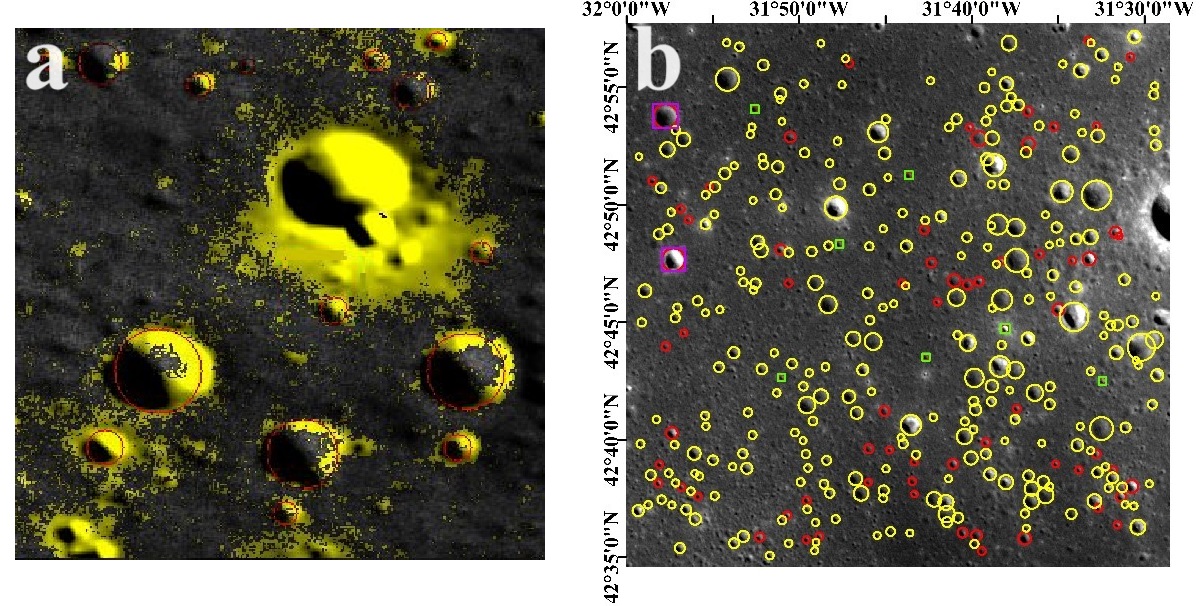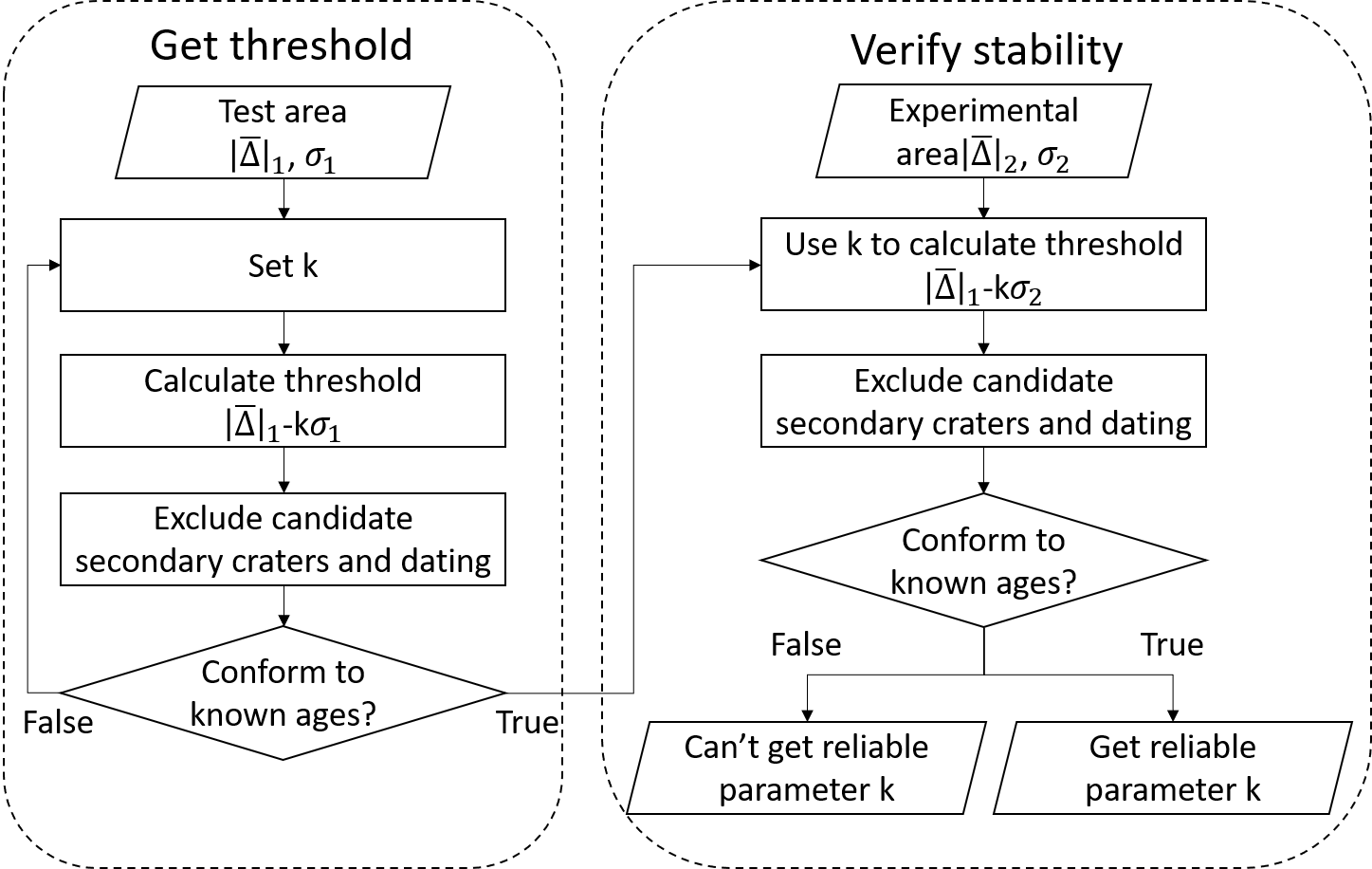Identification of Secondary Craters Based on Variations in Iron Composition on Lunar Mare
- 1School of Land Science and Technology, China University of Geosciences Beijing, China
- 2Institut für Planetologie, Universität Münster, Germany
- 3Research Center of Lunar and Planetary Remote Sensing Exploration, China University of Geosciences Beijing, China
- 4Subcenter of International Cooperation and Research on Lunar and Planetary Exploration, Center of Space Exploration, Ministry of Education of the People’s Republic of China, China
Introduction: Determining the age of a planet's surface can not only help distinguish the sequence of geological events and reveal clues of the planet's evolution, but can also support the selection of lunar exploration sites. Therefore, the determination of the lunar surface ages is very important for characterizing different geological units and investigating the geological history of the landing sites. At present, the widely used method for lunar surface dating is the measurement and fitting of crater size-frequency distributions (CSFD) [1]. One major challenge for this method is to avoid and/or remove of secondary craters that would yield incorrect ages if included in the CSFD. Secondary craters are typically identified based on their irregular morphology and shape compared to primary craters. However, there are some limitations in this method, because remote field secondary craters may have morphologies very similar to primary craters. Therefore, we developed a method to identify secondary craters on mare surfaces based on a contrast between the iron content of the surface inside and outside the crater.
Approach: The lunar regolith has unique mineralogical compositions and contains large quantities of nanoscale elemental iron due to space weathering [2]. In the study of data from Clementine and Apollo lunar highlands and mare, Ye et al. [3] found that the concentration of FeO inside craters was much lower than in their surroundings.

Figure 1. Distribution of iron in and around craters and identification of secondary craters. (a) Effect picture of error elimination (N39°-40° E323°-324°, the lower iron regions are shown in yellow, whereas higher iron areas are shown in gray). (b) Test Results and details for the Sinus Iridum area (yellow: primary craters; red: secondary craters; green: isolated secondary craters; purple: secondary craters with diameters larger than 400 m).
Because the depth/diameter ratio for primary craters is 0.12 and 0.06 for secondary craters [4], we infer that the iron content for secondary craters is more similar to that in the lunar surface soil than for primary craters. Hence, we first determine the mean FeO abundance within a given crater and then the mean FeO abunddance of the lunar soil outside the crater. The difference between these two abundances is calculated and a threshold value is obtained through comparative analysis to identify secondary craters. After the secondary craters are eliminated, the remaining craters are used to date lunar surface unit. We then compare our new results with known ages [5] to iteratively adjust the threshold and improve the method. However, possible sources of uncertainty in our method include potential compositional layering in the regolith. Ongoing work will examine this and other potential effects on our approach.

Figure 2. Flowchart for the determination of the recognition threshold for secondary craters.
Results: We selected areas in Tsiolkovsky crater and Sinus Iridum to develop our method. We used the multispectral data obtained by the multi‑band imager of the Japanese Selene Mission to determine the iron abundance. The result for the Sinus Iridum area is shown in Figure 1b. Most craters are primary craters (yellow). The identified secondary craters (red) are either chain-like or isolated (green), rather than clustered. Some of the secondary craters have diameters larger than 400 m (purple).
Discussion: To improve the reliability of secondary crater identification, the results were verified by CSFD. Our dating results were compared with existing ages. The similar age indicates that the method can identify secondary craters (Table 1). Besides morphological considerations and spatial patterns of secondary craters, our secondary crater identification method might provide an additional possibility to detect secondary craters and to eliminate them from CSFD measurements. Secondary Craters Not Excluded
Table 1. Dating Results (Ga)
|
Area |
Pasckert, 2015 Hiesinger, 2011 |
Secondary Craters Not Excluded |
Excluded Secondary Craters |
|
Tsiolkovsky Crater Area |
3.2 |
3.37 |
3.22 |
|
Sinus Iridum Area 1 |
3.0 |
3.47 |
3.02 |
|
Sinus Iridum Area 2 |
3.0 |
3.43 |
3.04 |
References: [1] Hiesinger, H., van der Bogert, C. H., Michael, G., Schmedemann, N., Iqbal, W., Robbins, S. J., Ivanov, B., Williams, J. P., Zanetti, M., Plescia, J., Ostrach, L. R., & Head, J. W., III. (2023). The Lunar Cratering Chronology. Reviews in Mineralogy and Geochemistry, 89(1), 401-451. [2] Taylor, L. A., & Meek, T. T. (2005). Microwave sintering of lunar soil: properties, theory, and practice. Journal of Aerospace Engineering, 18(3), 188-196. [3] Ye, L., Xu, X., Luan, D., Jiang, W., & Kang, Z. (2017). Automatic Detection and Recognition Of Craters Based on The Spectral Features Of Lunar Rocks and Minerals. Int. Arch. Photogramm. Remote Sens. Spatial Inf. Sci., XLII-3/W1, 199-204. [4] Plescia, J. B. (2015, March). Lunar crater forms on melt sheets—Origins and implications for self-secondary cratering and chronology. In 46th Annual Lunar and Planetary Science Conference (No. 1832, p. 2054). [5] Hiesinger, H., Head, J. W., III, Wolf, U., Jaumann, R., Neukum, G., Ambrose, W. A., & Williams, D. A. (2011). Ages and stratigraphy of lunar mare basalts: A synthesis. In Recent Advances and Current Research Issues in Lunar Stratigraphy (Vol. 477, pp. 0). Geological Society of America.
How to cite: Xu, X., Ye, L., Zhang, D., Kang, Z., Hu, T., Bogert, C. H. V. D., and Hiesinger, H.: Identification of Secondary Craters Based on Variations in Iron Composition on Lunar Mare, Europlanet Science Congress 2024, Berlin, Germany, 8–13 Sep 2024, EPSC2024-1145, https://doi.org/10.5194/epsc2024-1145, 2024.